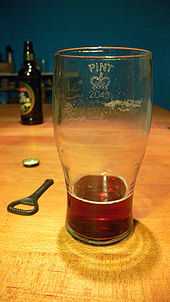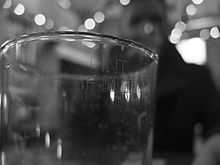Pint glass

A pint glass is a form of drinkware made to hold either a British ("imperial") pint of 20 imperial fluid ounces (568 ml) or an American pint of 16 US fluid ounces (473 ml). These glasses are typically used to serve beer, and also often for cider.
Current shapes
.svg.png)
The common shapes of pint glass are:
- Conical (or sleevers) glasses are shaped, as the name suggests, as an inverted truncated cone around 6 inches (15 cm) tall and tapering by about 1 inch (25 mm) in diameter over its height. Also called a "shaker pint" in the United States, as the glass can be used as one half of a Boston shaker. The most common size found in the US, such as those made by Anchor Hocking, holds 16 oz to the rim.
- The nonic, or "straight glass", a variation on the conical design, where the glass bulges out a couple of inches from the top; this is partly for improved grip, partly to prevent the glasses from sticking together when stacked, and partly to give strength and stop the rim from becoming chipped or "nicked".[1] The term "nonic" derives from "no nick".
- Jug glasses, or "dimple mugs", are shaped more like a large mug with a handle. They are moulded with a grid pattern of thickened glass on the outside, somewhat resembling the segmentation of a Mills bomb. The dimples prevent the glass slipping out of the fingers in a washing-up bowl, and the design of the glass emphasises strength, helping to withstand frequent manual washing. These design features became less important when manual washing was superseded by machine washing from the 1960s onwards. Dimpled glasses are now rarer than the other types and are regarded as more traditional.[2] This sort of glass is also known as a "Handle" or "Jug" due to the handle on the glass.
- Tulip is a more modern glass having a taller shape, usually flaring out towards the top; these designs are more commonly associated with continental lagers or promotional campaigns by breweries, and are frequently etched or marked with the beer's label.
Older styles
Older styles include:
- Decorative Toby jugs, although these would not have been for everyday use. Mid 1700s onwards.
- Pewter tankards. 1500s to 1900s
- Ceramic tankards with strap handles. Late 1800s to early 1900s.
- 10-sided glass tankards. 1920s and 1930s.[3]
-
.svg.png)
Glass tankard
United Kingdom law


In the United Kingdom, draught beer must be sold in Imperial measure (see Pint#Effects of metrication). United Kingdom law requires certain steps be taken to ensure that a pint of beer is indeed a pint. Though this can be achieved using "metered dispense" (calibrated pumps), the more common solution is to use certified one-pint glasses. Until recently these had a crown stamp and number etched upon them indicating that the certification had been done by an agency of the Crown.
Under the EU Measuring Instruments Directive (Directive 2004/22/EC), the certification of measuring instruments and devices used in trade (including beer mugs, weighbridges, petrol pumps and the like) can be done by third parties anywhere within the EU with governments taking "only the legislative and enforcement (market surveillance) functions" and "ensuring that the system of third party assessment ... has sufficient technical competence and independence"[4] (or, in simple language, calibration services were privatised). Glasses that have been certified by authorised firms anywhere within the EU have the letters CE etched on with the certifying agency's identification number.[5][6] Conservatives campaigning to have dual markings of crown and CE were informed by EU Commissioner Günter Verheugen that "a Crown stamp look-alike could naturally be affixed to the glass, as long as it is done in such a way that it is not confused with the CE marking".[7]
Selling beer in unmeasured glasses without using some other form of calibrated measure is illegal. Half-pint, one-third pint and two-thirds pint (schooners) glasses are also available, and are subject to the same laws.
Despite this emphasis on accurately measured glasses, there is a practice of defining a pint of beer as only 95 percent liquid.[8] It is common for drinkers to be served less than a full 20 ounce (568 ml equivalent) pint of liquid[9] — either because too much of the glass is taken up by a foamy "head", or simply because the customer has been sold a short measure. This allows publicans to sell more beer than the stated capacity of the cask or keg and hence save money. This practice may have consciously increased since the removal of a duty allowance on ullage (wastage). To counter this the British Beer and Pub Association have issued guidelines for bar staff to respect a customer who asks for a 'top up' to a full 20 ounce pint (568ml).[10]
For those wishing to avoid this practice while still serving beer with a large head, "lined" or "oversized" glasses are available. These have a line near the top (usually labelled "pint to line") to which the beer should be poured, with the head forming above it. In the past a number of breweries supplied these glasses to their pubs; this is now rarely the case and lined glasses are found mostly at enthusiasts' events such as beer festivals, serious cask ale pubs, and breweries' own bars. The use of lined 568 ml pint glasses in pubs is advocated by the Campaign for Real Ale.
Other countries

Beer in Australia is formally measured in metric units, but draught beer is commonly ordered and sold in glasses approximating imperial measures, including a 570 ml pint. (In the state of South Australia, "pint" refers to a 425 ml (¾ pint) glass, known as a schooner in the rest of Australia.) As in the UK, certified glassware must be used; the capacity of the beer glass is defined by either the brim or, where present, the capacity line.[11]
In Canada, Federal law mandates a standard imperial pint.[12] However, this law is rarely enforced, and establishments can sometimes get away with selling US pints or other measures as "pints."[13]
The Republic of Ireland uses a 20 ounce (approximately 568 mL) 1 pint glasses, where legal metrology marks are used to show that a glass has passed inspection by the National Standards Authority of Ireland, a state-run body which enforces a number of standard rulings. Starting in 2006, the NSAI "pint" mark, a circle featuring two wavy lines, between which "PINT" is written, with a year mark (last two digits), and a three digit batch code either side; has begun to be phased out with a European standard "PINT"/CE logo stamp. Smaller Pint glasses have been used in pubs and nightclubs though.
In Israel, although officially defined as 568ml,[14] pubs use the term rather arbitrarily and the "pints" served constitute a wide range of volumes (360ml-440ml). In the past, the custom was to serve beer in 330ml or 500ml in the original beer manufacture's glass. After the reform in the alcohol taxes at July 2012 the tax rate doubled.[15] Each liter of beer is charged with 4.2nis tax. In order to avoid raising prices at the pubs, and as a result, the loss of customers, a new "magic" appeared, called "pint".[16] The customers don't really know the vague term of a pint,[17] and it varies from place to place. Some of the places didn't even change the menu, and it's served as 500 ml.
In the United States, a pint is 16 US fluid ounces (473 mL). However, the typical conical "pint" glass holds 16 oz. to its rim. With a half inch of foam, the actual liquid fill is roughly 14 oz. Recently (as of 2008), some restaurants have replaced 16-ounce pint glasses (473 mL) with 14 ouncers (415 mL) to which customers have objected.[18] In response to this, legislation has been introduced in the state of Michigan (known for its craft brewing culture) to require bars to serve 16-ounce pints.[19]
Nucleated pint glasses

It is increasingly common to find pint glasses which contain markings on the base; very often these glasses are branded to one particular beer. The markings themselves are formed from small pits which aid in nucleation, allowing the gas within it to be released more easily, thus preserving the head. Without the aid of these pits a regular pint glass will keep a head for only 3 or 4 minutes before appearing 'flat'.[20] The markings come in a variety of styles ranging from a simple circular or square hatched pattern to more complicated branding messages.
Collecting

Pint glass collecting is an increasingly popular way for individuals to commemorate their visits to popular tourist destinations, most notably to microbreweries or sports arenas. These destinations often sell pint glasses adorned with their logos, which are either screen-printed or engraved on the side of the glass. Brewery enthusiasts may travel thousands of miles to see where their favorite beer is made or to sample new local and fresh beers, and collectors often display their collections (which sometimes total in the hundreds) in display cases or on shelves.
Beer festivals frequently have commemorative pint glasses made specially for the event.
References
- ↑ The Times: Last orders for traditional pint glass as search begins for alternatives
- ↑ The Independent: Collapse of Glass Firms Calls Time on Dimpled Jugs
- ↑ A Short History of Beer Glasses
- ↑ "Guide to the main administrative structures required for implementing the ACQUIS". European Commission. May 2005. Retrieved 16 November 2012.
- ↑ Discussion of the meaning of etched authority numbers
- ↑ Official list of approved verifiers (at December 2005) (PDF)
- ↑ News article on 'Conservative MEPs claim to have secured the future of the much-loved crown symbol on British pint glasses' (9/5/07)
- ↑ UK Parliament early Day Motion 988, Feb 20 2008
- ↑ "'Mine's a pint,' or is it?". bbc.co.uk. 2008-02-03. Retrieved 2008-08-29.
- ↑ The Publican 'BPAA Hits back at short pint claim' (31/07/06)
- ↑ Guide to the Sale of Alcohol, National Measurement Institute, 2010
- ↑
- ↑ | "Do you know how much beer is in your pint? Bet you don’t" | January 17, 2012
- ↑ פקודת המשקולות והמידות, 1947
- ↑
- ↑
- ↑
- ↑ Willamette Week | “Caveat Drinkor” | June 18th, 2008
- ↑ Anders, Melissa (8 October 2013). "Michigan proposal would mandate beer pints include at least 16 ounces". mlive.com. Retrieved 25 June 2014.
- ↑ Top tips for beer quality
External links
| Wikimedia Commons has media related to Pint glasses. |
- CAMRA's Full Pint Campaign page.
- Glass beer mugs collection - Private collection of about 5000 different items
| ||||||||||||||

